Next weekend will be the opening night of my latest exhibition! I'm very excited about it as it is the largest collection of my paintings that I have ever shown. Anyone who finds themselves in the neighborhood of Amsterdam is most welcome to come and see it. I will be there from 18.00 to 19.00; I will also be celebrating my birthday that night!
Journals23
Newest
New Exhibition
1 min read
Join the community to add your comment. Already a deviant? Log In
Wow a DD
1 min read
At a time when my life was feeling so dark... it is hard to tell you how happy it made me to see a ray of light in the form of a DD.
Thank you for your comments and thank you to everyone who watches and favs my work. I am ever grateful for your support.
Thank you for your comments and thank you to everyone who watches and favs my work. I am ever grateful for your support.
Join the community to add your comment. Already a deviant? Log In
If you're wondering where i've b
3 min read
So i sold my soul to make some cash to live on, and it turned round and bit me on the a**. it will serve me right to try to make art for picky opinionated customers who leave no room for my own artistic interpretation. What's the point in hiring an artist if you want a robot? they might as well have bought a photo printed on canvas. it would have saved me and them a lot of time, energy and wasted money. So they ended the contract, leaving me financially in the red. I admit i made some mistakes with this one, it's been hard to give an estimate for such a large piece of work, and i thought i could do it a lot faster than it turned out to take. and if i were them i might have done the same thing, but it still hurts when people call you unprofessional and accuse you of ripping them off... when in actual fact my quote was way way WWAAAAYYY too low in the beginning (and i never asked them to pay me more for what i thought we had agreed on) i guess i just got to put it down to experience and learn lessons from all our mistakes. But right now I'm fuming inside and need to rant.
Life sucks at the moment and it aint just the failed job, the other stuff is far worse and too personal to share with you. At least now i am free from the nightmare job and can go back to making things that i want to. i don't know if i'll be able to paint for a while tho, the stuff they said... it rings in my ears when i pick up a brush, and with everything else in my life right now i... i can't cope with it.
But i wanted to say to everyone who is trying to set a quote for a piece of work, especially if it's in a new area or a much larger project than you are used to... overestimate everything! including time, money and materials (you can always bring the price down again later)! that way you won't disappoint your customer, and you will scare away people who can't really afford your work. because working for someone who is on a tight budget is a nightmare and rarely works out to your benifit. of course if you have done it all a million times before you already know how to price your work and this little rant is of no help to you. but thank you for listening, i really needed to get it off my chest.
Life sucks at the moment and it aint just the failed job, the other stuff is far worse and too personal to share with you. At least now i am free from the nightmare job and can go back to making things that i want to. i don't know if i'll be able to paint for a while tho, the stuff they said... it rings in my ears when i pick up a brush, and with everything else in my life right now i... i can't cope with it.
But i wanted to say to everyone who is trying to set a quote for a piece of work, especially if it's in a new area or a much larger project than you are used to... overestimate everything! including time, money and materials (you can always bring the price down again later)! that way you won't disappoint your customer, and you will scare away people who can't really afford your work. because working for someone who is on a tight budget is a nightmare and rarely works out to your benifit. of course if you have done it all a million times before you already know how to price your work and this little rant is of no help to you. but thank you for listening, i really needed to get it off my chest.
Join the community to add your comment. Already a deviant? Log In
Demystifying Oil Painting
5 min read
- 1. Good equipment – Save up or splash out on a couple of decent brushes and a few good quality paints (suggested colours below) you can expand slowly, you don't need to be rich to start painting. 2. A good cleaning regime – Keep your brushes and pallet clean, no point ruining your good brushes by leaving them covered in paint or festering in the jar of turpentine. Clean them as soon as you are done for the day with warm water and soap until the water runs clear, leave them to dry naturally. If you want a quick and easy way to keep your pallet clean Leebea suggested to me “I wrap the pallet in foil and then mix my oils on the foil, then when I'm done rip it off and throw It away. The pallet always stays clean.” I think it’s a great tip. 3. The book: The Artists Handbook by Ray Smith will take you through everything you wanted to ask about oil painting and more. I find it an invaluable reference. 4. Life drawing skills are very important for anyone wishing to paint ‘realistically’! I cannot stress enough how much this will improve your ability to paint and draw with accuracy. Take a life drawing class as often as you can to keep improving your skills.
The pallet you use is as personal as a fingerprint, will develop as you do and also depends on what you like to paint. But if you wish to paint figuratively, and have no idea what colours to choose a good starting point would be to buy:
These colours are ones I use in my paintings that have skin tones. I avoid buying black because it is such a flat colour. You can create much better dark tones from mixing or glazing two opposing colours, for example a rich blue and a dark brown.
On a tube of paint you will see the name of the colour written, if it has the word ‘hue’ at the end this means it is an artificial pigment, and the colour will not go as ‘far’ as a natural one.
I will try to explain; think of the strength of colour in a pigment like the strength of taste in a hot chilli. Some hot chilli’s are tiny, only a couple of cm long and yet the tiniest bit of this chilli in a meal will make the whole thing very, very hot to taste. The flavour goes a long way with a small amount. In the same way, pigments in oil paint have many different strengths. Blue pigment, for example is very easy to find in nature, making it cheap for paint companies to use, therefore even student-grade oil paints have natural blue pigment in. A tiny dot of this blue mixed with other oils will go a long way, But other colours, like some reds are much harder to find in nature, so the oil paint companies make an artificial pigment called a ‘hue’ they put this ‘hue’ in their cheaper paints. A 'hue' is not strong at all so you have to use a lot of it to get a good strong colour on your canvas.
When buying paints you will find them priced according to their ‘series’, paints range over 5 or 6 series depending on the brand. The cheap series 1-2 paints will have many more hues in than the expensive ones. Don’t go buying all grade 5-6 paints, that’s a waste of money, but I do recommend you buy one or two of the more expensive paints, colours you use a lot or perhaps that are important to a particular painting you are working on. It's amazing the difference it can make to your work.
NB There are many different ways of painting in Oils, this is my way and my way is mostly traditional. This advice is not set in stone; in fact I encourage any artist - however well established - to regularly experiment with new ways of working. I write this article so that I can help those who are confused by oils or by painting figures, and it is also for people who want to know how another artist works.
If anyone has questions relating to oil painting, please note me and I will try to include the answer it in one of my articles.
Join the community to add your comment. Already a deviant? Log In
Advice for Painters Part III
6 min read
For previous info on this subject please read
 Advice for Painters part I and II</acronym> - Painting essentials, your pallet and painting meduims.
Advice for Painters part I and II</acronym> - Painting essentials, your pallet and painting meduims.
Advice for painters Part III</u>
 Transparent and Opaque Paints
Transparent and Opaque Paints
Transparent = so sheer as to permit light to pass through. Stained glass and clear plastic are transparent.
Opaque = not transparent or translucent; impenetrable to light; not allowing light to pass through.
By mixing a medium like linseed oil and turps to any oil paint you can make it transparent, and you can then use it for glazing. However, certain colours of oil paint are designed to be used as glazes. These colours are very dark or almost black when neat (not thinned with a medium), colours like: Alizarin crimson, Olive green, and Phthalo blue. When you unscrew the lid of the paint and look into the tube it looks almost black, it only shows its true colour when thinned by a medium, and it's true colour will be vibrant and lustrous.
These colours can, of course, be used to mix neat with other colours, but it is important to know what they are capable of as transparent glazes. If you didn't know about transparent oils I encourage you to find the oil paints you already have that look dark when neat, and mix them with some linseed oil and turps to see their true colour.
Opaque paints pretty much look the same neat as they do thinned down; they are designed to be mixed with other colours for your 'fatter' layers in your painting. (For more info on fat/thin layers see using oil mediums in Advice for Painters part II</acronym>)
Of course you can and should use opaque paints for glazes, but there might be a better transparent paint available to do the job better.
 Glazing
Glazing
Glazing is a process of painting involving laying thin translucent layers of paint on top of one another. To create a translucent layer mix a little oil paint with your chosen medium until it is thin enough to see through.
Each layer must be dry before you can paint the next, otherwise you will loosen the layer below and end up with a blotchy effect (it's a nice effect if you want to play with it, but it's unpredictable).
Imagine glazing like laying different colours of see-thru plastic over each other. If you took some see-thru blue plastic and laid it on white paper, it would still be blue, but lay a piece of yellow see-thru plastic over the blue on white, it would look green. Glazing in oils works in the same way, you lay different colours over each other to create colour.
Using this technique you can create many colours with a depth and lustrous quality that a simple wet mix of colours could not match.
Glazing is a tricky process to use because often you have to think 2 or three layers ahead and to understand the effects each colour has on another. It's still trial and error for me sometimes, but it is a technique that can produce the most amazing paintings.
One Deviant on this site who shows a great example of painting in glazes is cobainsriff these 6 photos show how he has build up the layers of glazes in his painting.
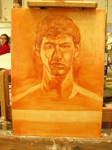
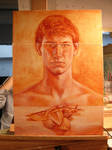
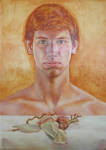
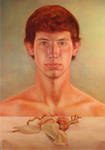
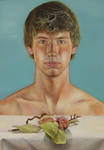
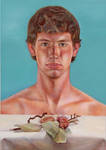
The Artist's Handbook by Ray Smith</i> has more photos of this process being used. I strongly advise anyone who wishes to understand glazing in more detail to take a look at this book.
There are many different ways of painting in Oils, this is just one way, my way and my way is mostly traditional. This advice is not set in stone; in fact I encourage any artist - however well established - to experiment constantly with new ways of working. I write this journal so that I can help those who are confused by oils or confused by painting figures, it is also for people who want to know how another artist works.
If anyone has further questions or has specific work they want me to critique, please leave them in the forum thread I have started on my page here: annagreaves.deviantart.com/jou…
Advice for painters Part III</u>
Transparent = so sheer as to permit light to pass through. Stained glass and clear plastic are transparent.
Opaque = not transparent or translucent; impenetrable to light; not allowing light to pass through.
By mixing a medium like linseed oil and turps to any oil paint you can make it transparent, and you can then use it for glazing. However, certain colours of oil paint are designed to be used as glazes. These colours are very dark or almost black when neat (not thinned with a medium), colours like: Alizarin crimson, Olive green, and Phthalo blue. When you unscrew the lid of the paint and look into the tube it looks almost black, it only shows its true colour when thinned by a medium, and it's true colour will be vibrant and lustrous.
These colours can, of course, be used to mix neat with other colours, but it is important to know what they are capable of as transparent glazes. If you didn't know about transparent oils I encourage you to find the oil paints you already have that look dark when neat, and mix them with some linseed oil and turps to see their true colour.
Opaque paints pretty much look the same neat as they do thinned down; they are designed to be mixed with other colours for your 'fatter' layers in your painting. (For more info on fat/thin layers see using oil mediums in Advice for Painters part II</acronym>)
Of course you can and should use opaque paints for glazes, but there might be a better transparent paint available to do the job better.
Glazing is a process of painting involving laying thin translucent layers of paint on top of one another. To create a translucent layer mix a little oil paint with your chosen medium until it is thin enough to see through.
Each layer must be dry before you can paint the next, otherwise you will loosen the layer below and end up with a blotchy effect (it's a nice effect if you want to play with it, but it's unpredictable).
Imagine glazing like laying different colours of see-thru plastic over each other. If you took some see-thru blue plastic and laid it on white paper, it would still be blue, but lay a piece of yellow see-thru plastic over the blue on white, it would look green. Glazing in oils works in the same way, you lay different colours over each other to create colour.
Using this technique you can create many colours with a depth and lustrous quality that a simple wet mix of colours could not match.
Glazing is a tricky process to use because often you have to think 2 or three layers ahead and to understand the effects each colour has on another. It's still trial and error for me sometimes, but it is a technique that can produce the most amazing paintings.
One Deviant on this site who shows a great example of painting in glazes is cobainsriff these 6 photos show how he has build up the layers of glazes in his painting.






The Artist's Handbook by Ray Smith</i> has more photos of this process being used. I strongly advise anyone who wishes to understand glazing in more detail to take a look at this book.
There are many different ways of painting in Oils, this is just one way, my way and my way is mostly traditional. This advice is not set in stone; in fact I encourage any artist - however well established - to experiment constantly with new ways of working. I write this journal so that I can help those who are confused by oils or confused by painting figures, it is also for people who want to know how another artist works.
If anyone has further questions or has specific work they want me to critique, please leave them in the forum thread I have started on my page here: annagreaves.deviantart.com/jou…
Join the community to add your comment. Already a deviant? Log In
